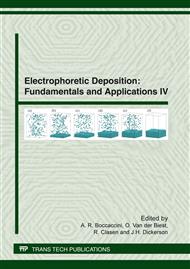[1]
S. Panigrahi, S. Bhattacharjee, L. Besra, B.P. Singh, S.P. Sinha, Electrophoretic deposition of doped ceria: Effect of solvents on deposition microstructure, Journal of the European Ceramic Society 30 (2010) 1097-1103.
DOI: 10.1016/j.jeurceramsoc.2009.06.038
Google Scholar
[2]
S. Bonnas, H.J. Ritzhaupt-Kleissl, J. Haußelt, Fabrication of particle and composition gradients by systematic interaction of sedimentation and electrical field in electrophoretic deposition, Journal of the European Ceramic Society 30 (2010).
DOI: 10.1016/j.jeurceramsoc.2009.08.007
Google Scholar
[3]
A.R. Boccaccini, J.A. Roether, B.J.C. Thomas, M.S.P. Shaffer, E. Chavez, E. Stoll, E.J. Minay, The electrophoretic deposition of inorganic nanoscaled materials, Journal of the Ceramic Society of Japan 114 (2006) 1-14.
DOI: 10.2109/jcersj.114.1
Google Scholar
[4]
L. Besra, M. Liu, A review on fundamentals and applications of electrophoretic deposition (EPD), Progress in Materials Science 52 (2007) 1-61.
DOI: 10.1016/j.pmatsci.2006.07.001
Google Scholar
[5]
I. Corni, M.P. Ryan, A.R. Boccaccini, Electrophoretic deposition: From traditional ceramics to nanotechnology, Journal of the European Ceramic Society 28(2008) 1353-1367.
DOI: 10.1016/j.jeurceramsoc.2007.12.011
Google Scholar
[6]
S. Jia, S. Banerjee, I.P. Herman, Mechanism of the electrophoretic deposition of CdSe nanocrystal films: Influence of the nanocrystal surface and charge; J. Phys. Chem. C 112 (2008) 162-171.
DOI: 10.1021/jp0733320
Google Scholar
[7]
S.A. Hasan, D.W. Kavich, S.V. Mahajan, J.H. Dickerson, Electrophoretic deposition of CdSe nanocrystal films onto dielectric polymer thin film, Thin Solid Films 517 (2009) 2665-2669.
DOI: 10.1016/j.tsf.2008.10.122
Google Scholar
[8]
L. Xinping, Y. Gao, L. Zheng, Template-free synthesis of CdS hollow nanospheres based on an ionic liquid assisted hydrothermal process and their application in photocatalysis, Journal of Solid State Chemistry 183 (2010) 1423-1432.
DOI: 10.1016/j.jssc.2010.04.001
Google Scholar
[9]
H.K. Sadekar, A.V. Ghule, R. Sharma, Bandgap engineering by substitution of S by Se in nanostructured ZnS1−xSex thin films grown by soft chemical route for nontoxic optoelectronic device applications, Journal of Alloys and Compounds 509 (2011).
DOI: 10.1016/j.jallcom.2011.02.089
Google Scholar
[10]
L. Luo, H. Chen, L. Zhang, K. Xu, Y. Lv, A cataluminescence gas sensor for carbon tetrachloride based on nanosized ZnS, Analytica Chimica Acta 635 (2009) 183-187.
DOI: 10.1016/j.aca.2009.01.020
Google Scholar
[11]
A.A. Yadav, M.A. Barote, E.U. Masumdar, Studies on nanocrystalline cadmium sulphide (CdS) thin films deposited by spray pyrolysis, Solid State Sciences 12 (2010) 1173-1177.
DOI: 10.1016/j.solidstatesciences.2010.04.001
Google Scholar
[12]
İ. Şişman, M. Alanyahoğlu, Ü. Demir, Atom-by-atom growth of CdS thin films by an electrochemical co-deposition method: Effects of pH on the growth mechanism and structure, J. Phys. Chem. C 111 (2007) 2670-2674.
DOI: 10.1021/jp066393r
Google Scholar
[13]
A. Azam, F. Ahmed, N. Arshi, M. Chaman, A.H. Naqvi, Formation and characterization of ZnO nanopowder synthesized by sol–gel method, Journal of Alloys and Compounds 496 (2010) 399-402.
DOI: 10.1016/j.jallcom.2010.02.028
Google Scholar
[14]
M. Lei, X.L. Fu, P.G. Li, W.H. Tang, Growth and photoluminescence of zinc blende ZnS nanowires via metalorganic chemical vapor deposition, Journal of Alloys and Compounds 509( 2011) 5769-5772.
DOI: 10.1016/j.jallcom.2011.02.029
Google Scholar
[15]
L. Feng, A. Lu, M. Liu, Y. Ma, J. Wei, B. Man, Fabrication and characterization of tetrapod-like ZnO nanostructures prepared by catalyst-free thermal evaporation, Materials Characterization 61 (2010) 128-133.
DOI: 10.1016/j.matchar.2009.10.011
Google Scholar
[16]
L. Jiang, M. Yang, S. Zhu, G. Pang, S. Feng, Phase evolution and morphology control of ZnS in a solvothermal system with a single precursor, J. Phys. Chem. C 112 (2008) 15281-15284.
DOI: 10.1021/jp804705v
Google Scholar
[17]
A. Vázquez, J. Aguilar-Garib, I. López, O. Cavazos, I. Gómez, Preparation of ZnS nanoparticles using microwave assisted synthesis: Effects of the irradiation power and the precursors, Rev. Mex. Fís. S 55 (2009) 57-60.
Google Scholar
[18]
S. Das, A.K. Mukhopadhyay, S. Datta, D. Basu, Prospects of microwave processing: An overview, Bull. Mater. Sci. 32 (2009) 1-13.
DOI: 10.1007/s12034-009-0001-4
Google Scholar
[19]
T. Serrano, I. Gómez, R. Colás, J. Cavazos, Synthesis of CdS nanocrystals stabilized with sodium citrate, Colloids and Surfaces A 338 (2009) 20-24.
DOI: 10.1016/j.colsurfa.2008.12.017
Google Scholar
[20]
W.W. Yu, L. Qu, W. Guo, X. Peng, Experimental determination of the extinction coefficient of CdTe, CdSe, and CdS nanocrystals, Chem. Mater. 15 (2003) 2854-2860.
DOI: 10.1021/cm034081k
Google Scholar


